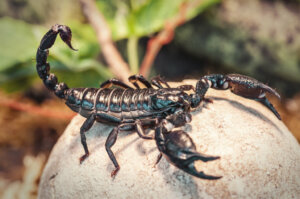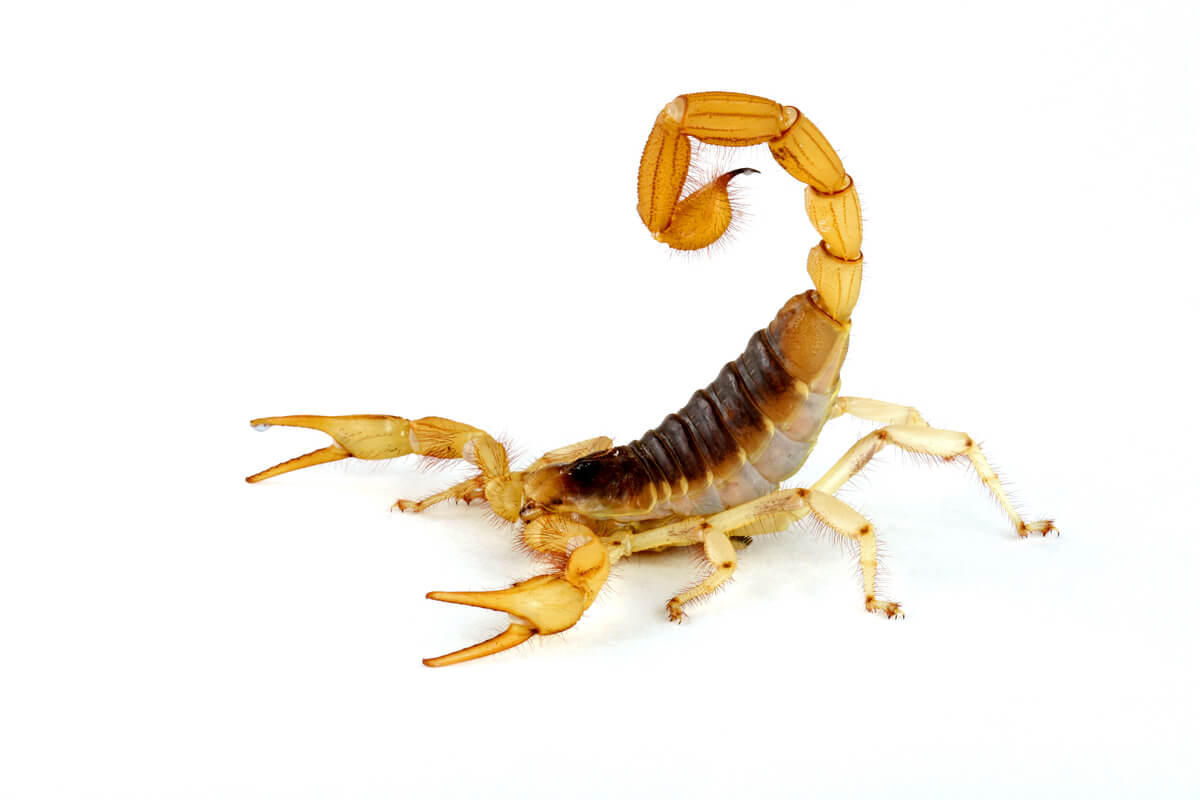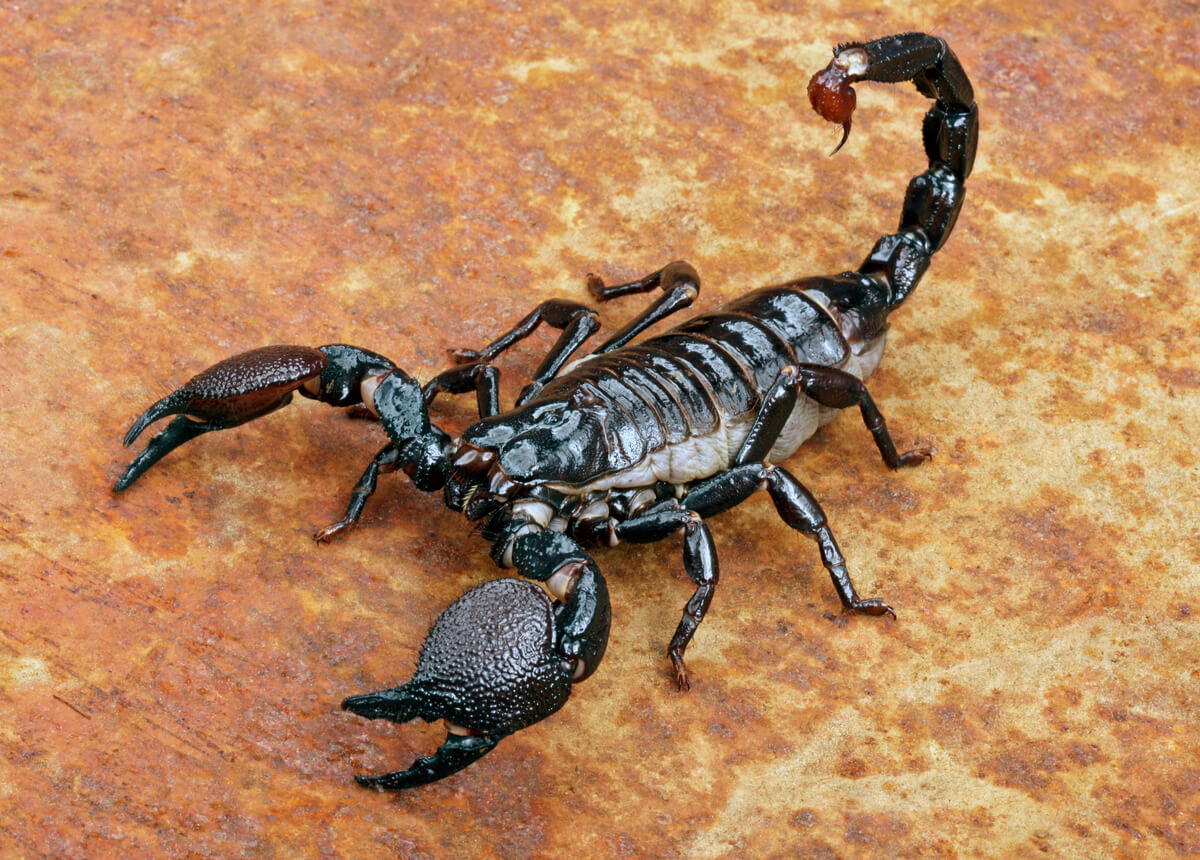What Do Scorpions Eat?

Scorpions are arachnid predators within the order Scorpiones. All have 8 legs, pedipalps modified with pincers and a tail ending in a stinger, which produces varying potencies of toxins. Apart from general information, knowing what scorpions eat helps their preservation and avoids problems in human environments.
These arachnids have an undeservedly bad reputation, as fewer than 50 species of the 2,500 discovered so far have a venom lethal enough to kill a human being. If you want to know more about the eating habits of the scorpion, read on.
General facts about scorpions
In the first place, we want to emphasize that we’re going to use the term ‘scorpion’ to describe all arachnids within the order Scorpiones, which comprises some 2,500 species divided into 22 recognized families. The evolution of this group dates back 435 million years and, throughout this time, the species have spread throughout the world – with the exception of the Antarctic continent.
If we want to get very technical, we should note that the Alacran genus only includes 3 species, which are, in turn, included in the Typhlochactidae family. These are endemic to Mexico and are found in the central area of the Sierra Madre Oriental —Puebla and Oaxaca. For this reason, throughout Central and South America the terms ‘scorpion’ and ‘alacran’ are used interchangeably.
Be that as it may, scorpions, or alacrans, have bodies that can be divided into 3 segments: cephalothorax (head), mesosoma (abdomen) and metasoma (tail). All have a shell, eyes, chelicerae, chelated pedipalps, 4 pairs of legs, and a tail ending in a stinger. As you can see, its morphological diversity is very low.

What do scorpions eat?
All scorpions are carnivores, that is, they feed on the organic matter provided by their prey. Most of them feed on grasshoppers, crickets, termites, beetles, and wasps. However, some species are also prepared to kill small vertebrates, such as rodents, amphibians, or lizards.
Like many other arachnids, scorpions digest food externally. With the help of their chelicerae, they break up the food into small parts, which are stored in an oral cavity, between the area of the chelicerae and the shell. The gastric juices are secreted in this chamber, so that the scorpion can ingest its food in the form of fluids.
How do scorpions hunt?
At this point, it should be noted that these arthropods are ectotherms. This means that they don’t generate their own heat with their metabolic reactions, and, therefore, they depend on the environment for thermoregulation. As studies indicate, the cells of ectotherms have fewer mitochondria – the energy-generating organelles par excellence – than those of endotherms.
For all these reasons, scorpions have much lower metabolic rates than a mouse or bird, for example. Their hunting strategy is of the sit and wait type, that is, they wait for an insect to pass through their lair and skillfully grasp it with their pincers, and then inject their poison. You’ll never see a scorpion chase its prey, as it literally doesn’t create enough energy for the race.
Depending on the species of scorpion, a specimen can kill smaller prey just with the force of its pincers. If the victim resists or poses a threat, the scorpion resorts to the sting with venom. Producing toxins is very demanding on its energy levels, and it only stings when it’s strictly necessary.
Based on this same rule, scorpions with larger claws are believed to have milder venom. On the other hand, the greater the prominence of the tail and the smaller the chelae, the more lethal the toxins will be.
Due to the metabolic cost of hunting, scorpions eat little in general and can last for months without hunting their prey.
Captive care of scorpions
You have to be very careful when acquiring scorpions as pets, as some species are lethal, and therefore, their possession without a permit is illegal. Housing a potentially dangerous animal in a domestic environment without the proper facilities is considered a crime.
The most commercialized scorpions are those of the genus Heterometrus, large, black in color and very prominent claws. They don’t pose a danger to humans, so no special permits are required for their possession. These animals possess a venom of negligible clinical relevance and rarely use the stinger.
To keep a specimen of this genus, a terrarium measuring 30 x 20 x 20 inches (12 x 8 x 8 inches) in length, width and height is enough. Universal substrate or coconut fiber are perfect as flooring and a minimum of 5 fingers of substrate should always be laid. Scorpions like to bury themselves and stay hidden for most of the day.
As far as environmental parameters are concerned, it’s best to keep the temperature between 20 and 30 degrees Centigrade (68-86 Fahrenheit) and the relative humidity at 80%. To achieve this, it’s enough to spray the installation with water about 2 or 3 times a week. In addition, giving a medium-sized live prey a week — a cricket or cockroach — to an adult specimen is usually sufficient. Scorpions don’t eat much.
It’s also necessary to place pieces of wood and caves so that the scorpion can take refuge.

Finally, it should be noted that dangerous species are also sold without permits in many regions. Be especially careful with scorpions of the genus Tityus and Androctonus, as they do have clinically significant poisons. Before buying any animal species, make sure of the professionalism of the seller and their characteristics.
All cited sources were thoroughly reviewed by our team to ensure their quality, reliability, currency, and validity. The bibliography of this article was considered reliable and of academic or scientific accuracy.
- Santibáñez-López, C. E., Francke, O. F., & Prendini, L. (2014). Shining a light into the world’s deepest caves: phylogenetic systematics of the troglobiotic scorpion genus Alacran Francke, 1982 (Typhlochactidae: Alacraninae). Invertebrate Systematics, 28(6), 643-664.
- Rand, D. M. (1993). Endotherms, ectotherms, and mitochondrial genome-size variation. Journal of molecular evolution, 37(3), 281-295.
- Nakagawa, Y., Lee, Y. M., Lehmberg, E., Herrmann, R., Herrmann, R., Moskowitz, H., … & Hammock, B. D. (1997). Anti‐Insect Toxin 5 (Aalts) from Androctonus Australis. European journal of biochemistry, 246(2), 496-501.
- Uawonggul, N., Chaveerach, A., Thammasirirak, S., Arkaravichien, T., Chuachan, C., & Daduang, S. (2006). Screening of plants acting against Heterometrus laoticus scorpion venom activity on fibroblast cell lysis. Journal of ethnopharmacology, 103(2), 201-207.
This text is provided for informational purposes only and does not replace consultation with a professional. If in doubt, consult your specialist.